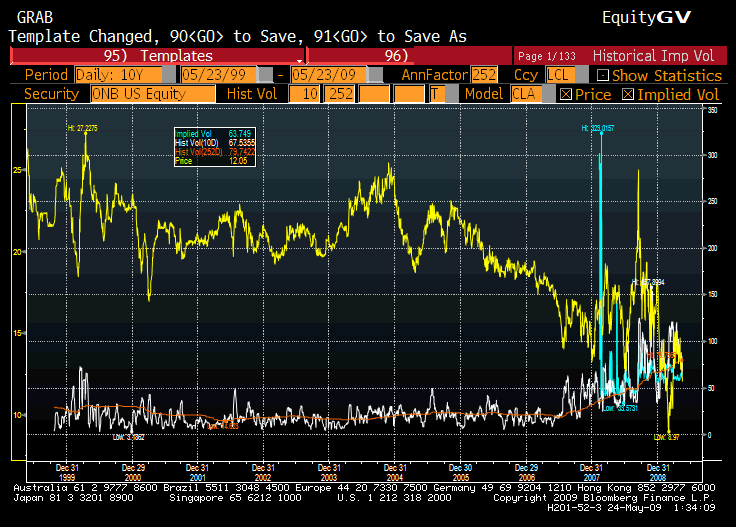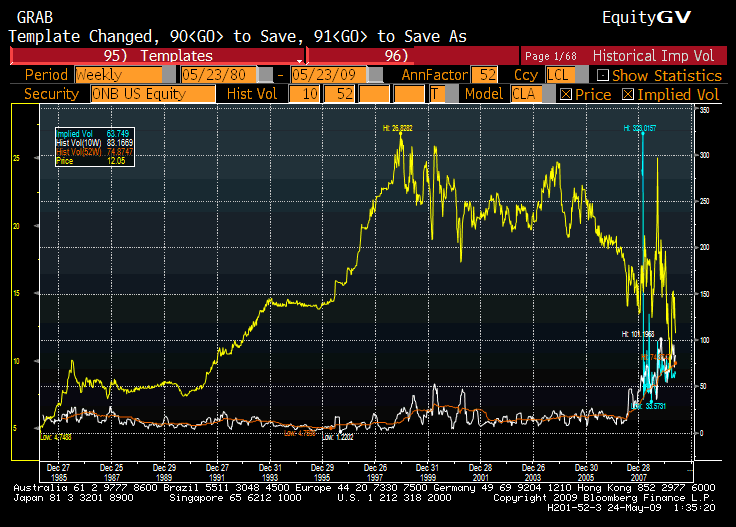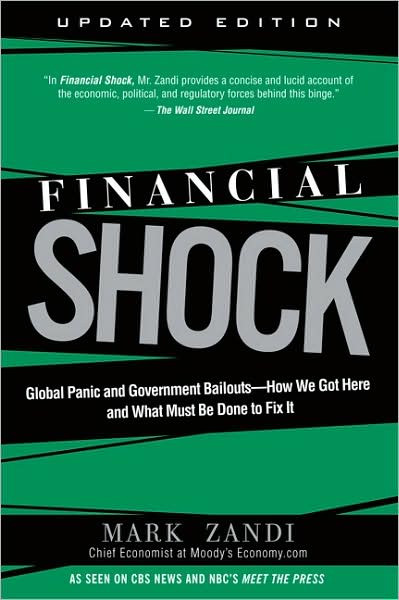What is the Sound of One Hand Clapping? What is the Right Price when there is no Market?
No, this isn’t another discussion of SFAS 157, though there are some similarities.? There has been a bit of a brouhaha over repayment of TARP options.? Isn’t the government getting shortchanged?
Maybe.? Maybe not.? This one is tough to answer, because at least as yet, there is no active market available for really long-dated call options.? Let me give you an example from my own experience.
I used to run a reasonably large options hedging program for a large writer of Equity Indexed Annuities [EIAs].? Much as I did not like the product, still I had to do my job faithfully, and when we were audited by a third party, they commended us having an efficient hedging program.
But here was our problem:? the EIAs lasted for ten years, but paid off in annual installments, based on average returns over each year.? Implied volatility might be low today, and the annual options that we purchased to hedge this year might be cheap, but the product had many years to go.? What if implied volatility rose dramatically, making future annual hedges so expensive that the company would lose a lot of money?
Maybe there could be another way.? What if we purchased the future hedges today?? A few problems with that:
- We don’t know how much we need to purchase for the future — the amount needed varies with how much the prior options would finish in the money.
- But the bigger problem is once you get outside of three years, the market for options, even on something as liquid as the S&P 500, is decidedly thin.? There’s a reason for that.? The longer-dated the option, the harder it is to hedge.? There are no natural sellers of long dated options, and relatively few Buffetts in the world who are willing to speculate, however intelligently, in selling long-dated options.
There is an odd ending to my story which is tangential to my point, but I may as well share it.? Eventually, the insurance company wanted to make more money, and felt they could do it by hiring an outside manager (a quality firm in my opinion — I liked the outside manager).? But then they told them not to do a total hedge, which was against the insurance regs, given their reserving practices.? Not hedging in full bit them hard, and they lost a lot of money.? Penny wise, pound foolish.
So what about the TARP options?? Did the US Government get taken to the cleaners on Old National Bank?? Is Linus Wilson correct in his allegations and calculations?? Or is jck at Alea correct to be a skeptic?
It all boils down to what the correct long term implied volatility assumption is.? Given that there is is no active market for long-dated implied volatility / long-dated options for something as liquid as the S&P 500, much less a mid-sized bank in southern Indiana, the exercise is problematic.
In quantitative finance, one of the dirty secrets is that common parameters like realized volatility and beta are not the same if calculated? over different intervals.? Also, past is not prologue; just because realized or implied volatility has been high/low does not mean it will remain so.? It tends to revert to mean.? With the S&P 500, implied volatility tends to move 20% of the distance between the current reading and the long term average each month.? That’s pretty strong mean reversion, though admittedly, noise is always stronger in the short run.
Let’s look at a few graphs:
Daily Volatility for ONB:
Or weekly:
or monthly:
or quarterly?
Here’s my quick summary: the longer the time period one chooses, the lower the volatility estimate gets.? Price changes tend to mean revert, so estimates of annualized realized volatility drop as the length of the period rises.? Here’s one more graphic:
I’m not sure I got everything exactly right here, but I did my best to estimate what volatility level would price out the options at the level that the US government bought them.? I had several assumptions more conservative than Mr. Wilson:
- In place of a low T-bill rate for the risk-free rate, I used the 10-year Treasury yield.? (Which isn’t conservative enough, I should have used the Feb-19 zero coupon strip, at a yield of 3.79%.)
- I set dividends at their current level, and assumed they would increase at 5% per year.
- I modeled in the dilution from warrant issuance.
But I was more liberal in one area.? I assumed that ONB would do an equity issuance sufficient to cut the warrants in half.? If the warrants were outstanding, the incentive to raise the capital would be compelling, and it would get done.
The result of my calculation implied that a 21% implied volatility assumption would justify the purchase price of the warrants.? That’s nice, but what’s the right assumption?
There is no right assumption.? Short-frequency estimates are much higher, even assuming mean reversion.? Longer frequency estimates are higher if one takes the present reading, but lower if one looks at the average reading .? After all, Old National is a boring southern Indiana bank.? This is not a growth business.? If it survives, growth will be modest, and the same for price appreciation.
The Solution
It would be a lot better for the US Treasury to get itself out of the warrant pricing business, and into the auction business, where it can be a neutral third party.? Let them auction off their warrants to the highest bidder, allowing banks to bid on their own warrants.? I’ll give the Treasury a tweak that will make them more money: give the warrants to the winning bidder at the second place price.
By now you are telling me that I am nuts — giving it to the winner at the second place price will reduce proceeds, not increase them.? Wrong!? We tell the bidders that we want aggressive bids, and that they will get some of it back if they win.? I’ve done it many times before — it makes them overbid.
So, with no market for these warrants, I am suggesting that the Treasury creates their own market for the warrants in order to realize fair value.? Is it more work?? Yeah, you bet it is more work, but it will realize better value, and indeed, it will be more fair.










